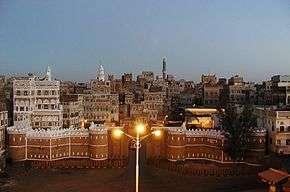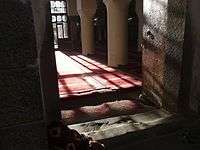Great Mosque of Sana'a
| Great Mosque of Sana'a Al-Jāmiʿ al-Kabīr bi-Ṣanʿāʾ الجامع الكبير بصنعاء | |
|---|---|
|
Great Mosque in Sana'a. | |
 Shown within Yemen | |
| Basic information | |
| Location |
|
| Geographic coordinates | 15°21′11″N 44°12′54″E / 15.3531°N 44.2149°ECoordinates: 15°21′11″N 44°12′54″E / 15.3531°N 44.2149°E |
| Affiliation | Islam |
| Municipality | Sana’a |
| District | Sana’a |
| Prefecture | Sana’a |
| State | Yemen |
| Region | Yemen |
| Year consecrated | 7th -8th century |
| Ecclesiastical or organizational status | In use |
| Status | Active |
| Leadership | Initially Prophet Muhammad and later Umayyad caliph al-Walid I |
| Architectural description | |
| Architectural type | Mosque |
| Architectural style | Umayyad |
| Groundbreaking | 630 AD |
| Completed | Renovation 705 and 715 AD |
| Specifications | |
| Length | 80 m |
| Width | 60 m |
| Minaret(s) | Two |
| Materials | Brick and stone |
Great Mosque of Sana'a (Arabic: الجامع الكبير بصنعاء Al-Jāmiʿ al-Kabīr bi-Ṣanʿāʾ) is an ancient mosque in Sana'a, Yemen, just east of the old Ghumdan Palace site.[1] Dating to the seventh century, it was reportedly built in part from the materials of the Ghumdan palace. This was destroyed by Caliph Uthman because he feared it could be used as a stronghold for a rebellion
Local legend traces the mosque's history to the period of Muhammad. The building has undergone several renovations in later centuries.[2] An important archaeological find was the Sana'a manuscript, discovered here during restoration in 1972. It had some early manuscripts of the Koran.

.jpg)
Geography
The mosque was built upon the site of the Ghumdan Palace, between the two areas of Sana'a, Al-Quati and Al-Sailah. The city's souq was moved next to the mosque, affording it with greater safety because of its proximity to a religious building.[3] Along with the mosque, the palace site also houses a prison and barracks for the armed forces, built during the Ottoman Empire.[4][5]
In later years, city planning, expansion and orientation were greatly influenced by the construction of the Great Mosque and two other mosques on the city's north side.[3] Though there are more than one hundred mosques in the Old City, the Grand Mosque is the largest and most notable of them.[6]
History
According to local legend,[6] the Prophet Muhammad was associated with the mosque's planning and construction around 630 AD (6 AH), though there is no evidence to support this.[7] Sana'a was central in the propagation of the Islamic religion in the post-Hegira period, when most pre-Islamic structures were destroyed. Many of the archaeological finds discovered in the Great Mosque substantiate its construction to the era when Mohammed was supposed to live. The traditional history of his life places him in the period when the Ghumdan Palace and the cathedral were demolished, and the material recovered from them was used to build the mosque.[8]
Its confirmed history dates from 705 to 715 (86-96 AH), when the Umayyad caliph al-Walid I expanded the mosque to much larger dimensions. The interior stone arcades of the flat roofs of the mosque are stated to be of the Byzantine architectural features of the Axumite Empire. An inscription in the pre-Islamic language of the region, in a stone arch support, a reused piece, connects it to Byzantine architecture.[7] Another inscription found in the courtyard of the mosque dates to 753 AD, of the Abbasid period.
Two minarets were built: one on the east side was constructed in the early 9th century, and the one on the west was built in the 12th century. Floods twice caused substantial damage to the mosque, after which it was totally renovated.[2] Karmatis invaded the city in 911 and damaged the mosque.
Much restoration was done in 1130 by the Isma`ili Queen Arwa ibn Ahmad. She was responsible for the elegantly sculpted ceilings of the mosque's eastern, western, and northern wings. She was closely linked to the Fatimid dynasty in Egypt. The mosque's western minaret, which she had built, is similar to those of the mosques of the same period built in Cairo.[7]
In the early 16th century, the mosque was renovated with a domed square structure and the paving of its courtyard.[7]
.jpg)
Architecture and fittings


The central courtyard measures 80 by 60 metres (260 ft × 200 ft), with prayer halls arranged in a north-south direction. Halls with three aisles aligned along the east-west direction are built with materials of the pre-Islamic period brought from other areas. The building designs have various interpretations.
One view is that it was an Ottoman Period structure, as the mosque shares similarities with the Ka'ba at Mecca. Another view states that its ablaq design, with alternating layers of varying colored material, dates it to a pre-Islamic period. The wooden ceilings, made of lacunari’s wood, are carved and painted.[9] The building was used to store waqf documents, and has a large library and other ancient manuscripts.[6][7]
Discoveries
In 1972-3, when plaster was removed by archaeologists, they discovered some 65 artifacts connected to the capital when it contained the Cathedral of Sana’a.[2] These items included large quantities of old manuscripts and parchments, as well as the Sana'a manuscript, found by construction workers while renovating an attic wall. Not realizing the value of their find, they gathered up the documents, packed them away into potato sacks, and left them on the staircase of one of the mosque's minarets.[10]
Also discovered while removing the plaster were twelve ancient copies of the Koran (parchments in Kufic script), as well as four thousand rare Arabic manuscripts linked to the start of Islam, the Umayyad period, and Sheba's Palace of Ghamdan and its destruction. The Koran found here is said to have been written or compiled by Imam Ali. The library in the mosque has preserved these finds.[11] Early book bindings found at the mosque have been well documented by scholars such as Ursula Dreibholz (1997).[12] Other archaeological finds at the Great Mosque are remnants of vaults and old buildings, unearthed in 2006 under the guidance of Dr. Mary Lynn, a French archaeologist.
Preservation
The Great Mosque is included on the UNESCO World Heritage Site List, designated in 1986 as list no. 345, under Criteria: (iv)(v)(vi), which includes 103 mosques, 14 hammams and over 6,000 houses of Sana’a, all built prior to the eleventh century.[8] Preservation of the Great Mosque, which is of exceptional religious and historical value, has been supported by UNESCO's World Heritage Institute of Training and Research-Asia and Pacific (Shanghai). Analysis of the damages suffered by the mosque over several centuries of neglect has been identified as due to floods, rains, soil subsidence, old electrical wiring and connections, ground water seepage, vandalism and wars, and also very weak old buildings adjoining the mosque. These problems have been well documented.
Repairs and maintenance, initiated in 2003, continue to be carried out in phases, such as electrical system renovation. Plastering has been redone, including restoration of the old traditional plaster work called qudad. Pavings have been improved and minarets are being restored. Improvements have been made in ablution areas and modern toilets were added. Other improvements have been made to the water supply and sewerage systems, as well as removal of old buildings which do not match with the historical and architectural features of the mosque.[11]
References
- ↑ Google Maps (Map). Google.
- 1 2 3 Talgam, Rina (2004). The Stylistic Origins of Umayyad Sculpture and Architectural Decoration: Text. Otto Harrassowitz Verlag. pp. 112–. ISBN 978-3-447-04738-8. Retrieved 25 December 2012.
- 1 2 Elsheshtawy, Yasser (2004). Planning Middle Eastern Cities: An Urban Kaleidoscope in a Globalizing World. Routledge. pp. 91–. ISBN 978-1-134-41010-1. Retrieved 29 December 2012.
- ↑ McLaughlin, Daniel (12 February 2008). Yemen: the Bradt travel guide. Bradt Travel Guides. p. 86. ISBN 978-1-84162-212-5. Retrieved 11 July 2011.
- ↑ "Restoration of the Great Mosque in Sana'a, Yemen". UNESCO. Retrieved 25 December 2012.
- 1 2 3 Steil, Jennifer (5 July 2011). The Woman Who Fell from the Sky: An American Woman's Adventures in the Oldest City on Earth. Random House Digital, Inc. pp. 5–. ISBN 978-0-7679-3051-2. Retrieved 29 December 2012.
- 1 2 3 4 5 "Al-Jami' al-Kabir". ArchNet Digital Libraray. Retrieved 25 December 2012.
- 1 2 "Old City of Sana'a". UNESCO Organization. Retrieved 25 December 2012.
- ↑ "From Material to Structure: Mechanical Behaviuor and Failures of the Timber Structures" (pdf). ICOMOS Organization. Retrieved 25 December 2012.
- ↑ Lester, Toby (January 1999). "What Is The Koran". The Atlantic Monthly. Retrieved 29 December 2012.
- 1 2 "Restoration of the Great Mosque in Sana'a, Yemen". World Heritage Institute of Training and Research-Asia and Pacific (shanghai) of Unesco. Retrieved 25 December 2012.
- ↑ Gacek, Adam (24 June 2009). Arabic Manuscripts: A Vademecum for Readers. BRILL. p. 302. ISBN 978-90-04-17036-0. Retrieved 29 December 2012.